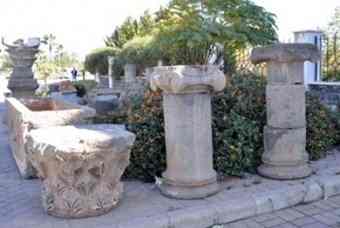The Daraa Department of Archaeology gathered over 200 artifacts currently being housed in the National Museum in Daraa, including sarcophagi, columns, crowns, mosaics and jars.
 According to Curator of the National Museum Ayham al-Zoabi, the artifacts that were collected from across Daraa governorate include 10 large sarcophagi, grape and olive presses, columns and crowns, and dozens of stone pieces bearing texts.
According to Curator of the National Museum Ayham al-Zoabi, the artifacts that were collected from across Daraa governorate include 10 large sarcophagi, grape and olive presses, columns and crowns, and dozens of stone pieces bearing texts.
He pointed out that the process of collecting these artifacts revealed Roman and Greek finds in the western region of the governorate, dispelling the previous notion that Greco-Roman relics were confined to the eastern region.
Al-Zoabi pointed out that the museum's garden has become a gallery of large artifacts that sums the history of the southern region. These artifacts include basalt statues depicting ancient historic figures and gods, in addition to sarcophagi, mosaics, jars and basalt columns.
The 200 artifacts will be categorized according to historic period and significance, joining the 1700 artifacts housed in the museum's halls.
The most important artifacts in them museum include sarcophagi from the Middle Bronze Age (2000-1600 BC), jars from the Modern Bronze Age (1600-1200 BC), two statues from the Roman era depicting gods, a figure depicting a local lord riding a horse, and a coin struck in Damascus bearing the image of Emperor Philip who ruled Rome between 244 and 249 BC. This coin is one of two existing copies, the second being displayed at the Morgan Library & Museum in New York.
Author: H. Sabbagh | Source: Global Arab Network [December 05, 2010]
VIA «Archaeological history of Syria displayed in 200 artifacts at Daraa Museum»